LIPIcs.CCC.2019.27.pdf
- Filesize: 0.75 MB
- 29 pages

 Creative Commons Attribution 3.0 Unported license
Creative Commons Attribution 3.0 Unported license







































Feedback for Dagstuhl Publishing